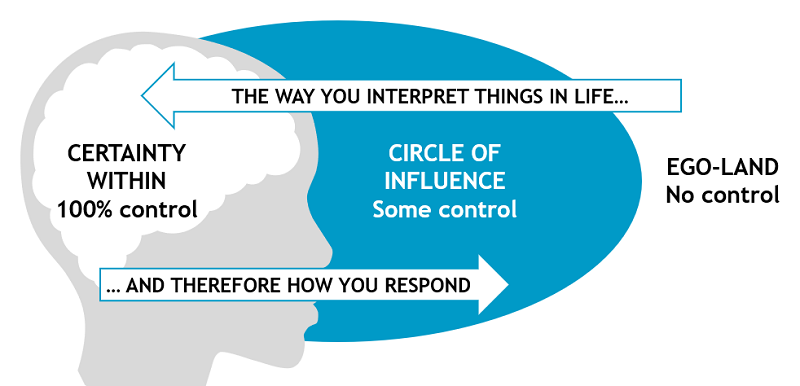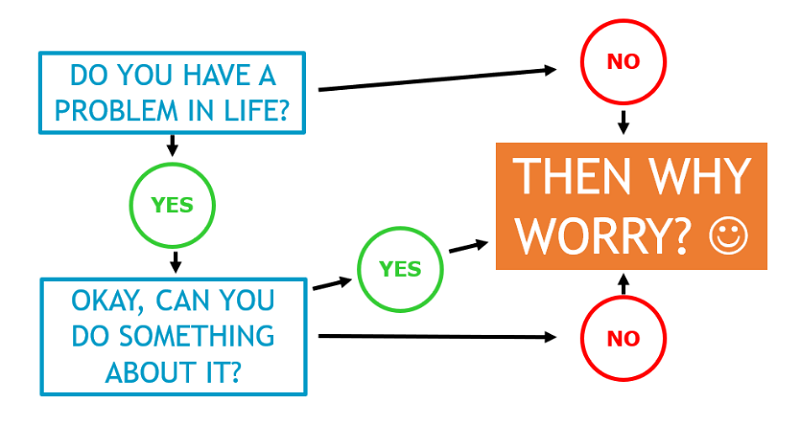What’s in Our Control, What’s Not
Episode #4 of the course Confident conflict management by Martin Probst
Welcome back.
Yesterday, I introduced you to the concept of identifying and confidently handling conflict. Today, we will gain clarity about what is in your control—and more importantly, what’s not.
If we want to successfully manage conflict, one of the first steps to take is to acknowledge that we do not have control over how other people react. The only thing we have control over is how we conduct ourselves and react to what is coming at us from the external environment.
“You can’t control the world, but when you control your thoughts, you bring order.” —Bernie Siegel
If you believe that the other person or the situation is the problem, you are at effect and hand over all the power by believing you don’t have any. And if the other person or situation really is the problem, wouldn’t you prefer to have as much control or empowerment as possible, to deal with the situation effectively by influencing the other person’s behavior in a positive way?
Our mind needs to shift from “what’s out there has to change first” to “what changes can I make in order to change what’s out there”.
The Circle of Influence
There is actually only one thing that we have 100% control over, and that is the certainty within ourselves. And this “certainty within” is based on only two things: the way we interpret events in life, and how we respond to them.
It’s as simple as that; we have 100% control over ourselves!
There is a correlation between our internal world (our state of mind or mindset, including our confidence and self-esteem) and the external world (what’s happening outside of us). The more certainty, confidence, and control a person has within themselves, the less certainty or control they need in the world they live in. Because they know that they possess the confidence and tools to deal with whatever comes their way, which certainly helps when we get into stressful situations in the workplace, at home, or in other areas of our lives.
How you respond to situations will influence the people around us, in other words, the environment we live in (workplace, home, sports club, etc.). This is our circle of influence, where we have some control. Where our circle of influence ends is where our control and responsibility end too. Why? Because it is the other person’s responsibility and choice of how they will interpret our response. This is where their control starts.
If you truly understand this concept, it will be a real game-changer. It gives you certainty within and empowers you in such a way that stress and a lack of confidence are no longer an option.
We must understand and accept that we can not change other people. However, we can change ourselves which is 100% in our control. So, the second we take full responsibility for how we handle conflict situations, we change our immediate environment and therefore the people around us. This is the true influence and the limit of our responsibility. Changing the other person is their responsibility—not ours.
Unfortunately, our Ego is highly skilled in creating problems by adding a complicated story to experience. Although our ego is there to protect us, it loves complexity and does not always serve us in an empowering way. It often leads to fear-driven behaviors as the ego is purely interested in:
• knowing
• judging
• justifying
• being right
• looking good
• getting even
How to overcome our Ego and to stay calm during conflict situations will be our topic in tomorrow’s lesson. Meanwhile, what we can do is being a role model to the people around us, be it family members, work colleagues, or social friends, in how we conduct ourselves, how we handle situations, and how we motivate ourselves. If we want to positively influence behavioral change, we must put our time and energy to where we can actually achieve an outcome and make a difference.
Know Where to Draw the Line
Unfortunately, in today’s busy world we rarely take the time to learn how to be our best friend, how to trust and listen to ourselves, and how to become our own best coach to overcome our problems and challenges.
When we experience a great and amazing life, it is generally based on how well we can overcome certain problems, how independent we are, and how much confidence we have in ourselves. We can overcome many problems in our lives simply by trusting ourselves more and taking the required actions to do something about them.
Understandably, this diagram makes sense in theory but can prove a little trickier to execute in reality. That’s because many of us struggle to follow through and to trust ourselves during stressful and sticky situations. We must clearly understand what is in our control—and what is not and learn to stick to our guts.
My top tip for the day: All too often, we try to control our environment when we have just learned that the only factor we have control over is our own actions and how we react to the actions of others. Today, observe your reaction to what usually ticks you off and apply the “Why worry?” principle.
Tomorrow, we will learn why we must separate people from their behaviors to successfully manage conflict.
“Dare to make a difference!”
Martin
Recommended reading
Before you lose your mind: How to apply effective mindfulness methods
Recommended book
Share with friends



